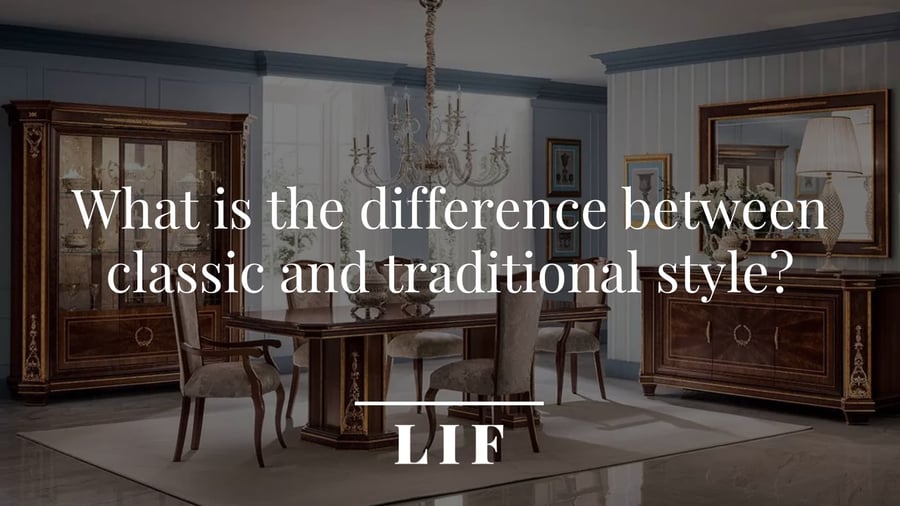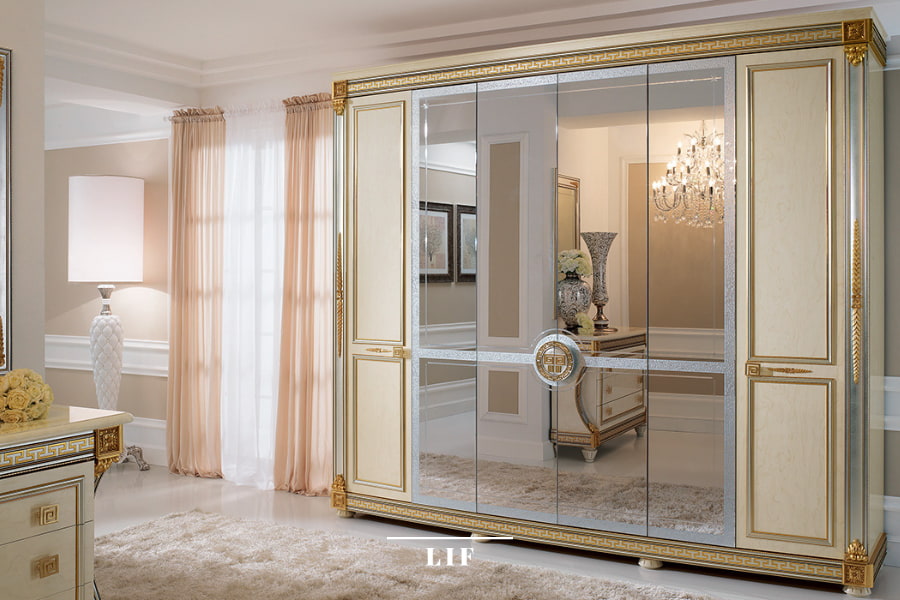There is a subtle difference between classic and traditional style in interior design: find out the features of both to furnish your home.
They are often confused with each other and overlapped as if they were the same thing: in fact, classic and traditional in interior design are not synonyms; they do not have the same conceptual value and stylistic weight. These are two similar but not identical ways of decorating.
Learning to recognize the difference between classic and traditional style is the first step to decorating with full awareness of the atmosphere and "mood" to convey in your home.
The difference between classic interior design and traditional furniture style is mainly originating from the materials and "richness" of the two styles, but also from the predominance, regarding the latter, of a more intense and lively chromatic research, a less neutral one. These aspects are added to a desire for simplicity that dominates in the traditional style while the classic style loves pomposity.
In any case, since in this blog we repeatedly reviewed the peculiarities of the classic style in interior design, let's now review the characteristics of the traditional style, analyzing for each point the differences and the similarities between the two.
This is what we will be discussing in this article:
- What is traditional and classic style in Interior Design? A story that starts in the past
- Classic or traditional style? Make your choice and furnish your home with elegance
Let us look at each topic individually.

What is traditional and classic style in Interior Design? A story that starts in the past
Traditional furniture in interior design has its roots in the trendy European design in the 18th and 19th centuries especially in France and England, from which it still takes some architectural and decorative elements. However, compared to the rather elaborate and opulent styles of the time, the traditional furniture style favors moderation and elegance. Luxury is there but it is balanced and "camouflaged" in the details and in the choice of fine materials and finishes. The result is a harmonious and balanced overall appearance without excess.
We could define traditional furniture as a warmer and cozier version of the pure classical style, which is instead characterized by more ethereal and noble atmospheres.
Traditional style, although less lavish than classic interior design, shares with the latter an aura of refinement and timeless beauty. The "objective" beauty that goes beyond fads and trends precisely because it is based on quality, taste and stylistic sophistication.
The most obvious difference between classic and traditional style is that the latter exploits references to the past in a flexible way, offering an aesthetic idea that is less ostentatious (as well as, generally, more affordable) and linked more to the concept of hospitality than luxury.
Simplifying, we could say that the classical style can be recognized by its ability to be timeless and remain true to itself. It is no coincidence when one says that a dress, a song or anything else has become "a classic" when it goes beyond fashions and eras and can "speak" universally and across time.
The traditional style, on the other hand, likes to create warm and familiar atmospheres, even with the addition of small touches of different stylistic elements (modern, vintage, bohemian, etc.), while maintaining balance, harmony and proportion, both formal and structural, typical of traditional design.
Difference between classic and traditional style: from neutral shades to wider range of bright colors
When starting to decorate your home or an individual room, it is essential to use a color palette that reflects the characteristics of the chosen style as closely as possible. Color, in fact, is one of the most influential elements in defining the decor.
That is why, going more into the specifics of the differences between classic and traditional style, one of the first aspects to consider in learning to distinguish between the two stylistic styles is precisely the macrostructure of color.
In this discourse about the differences and similarities, color tends to present itself in a very different way between traditional furniture and classic interior design.
The latter, in fact, prefers a clear and soft chromaticism, basically neutral, designed to highlight the prestigious materials of the furniture and avoid evident contrasts (thus increasing also calm and familiarity).
In traditional furnishing, the range of hues is much wider and richer: even if it does not avoid neutral colors, it can range from red to green, from yellow to blue, searching for more lively and accented patterns.
We are not talking about an anarchy of color: it should not be forgotten that each element should be weighed in a proportionate and harmonious way with the overall environment, in the traditional as well as in the classic style.

Classic and Traditional Furniture: understanding the differences in details and finishes for timeless interiors
The classic interior design is extremely pure and with a strong identity.
Each element of the room, placed in a context that must not forget the harmonious trend of the style itself, in addition to comply with a certain essential appearance (a balanced magnificence of sorts) shows off its elegance and refinement.
Classic style focuses mainly on the value and wealth of materials, finishes and decorations, such as:
- Oak, mahogany and cherry wood
- Ceramic and marble
- Gold and silver finishes
- Stuccoes, friezes, cornices and other architectural elements that recall antiquity
The traditional furniture style, on the other hand, uses, as already explained, lines and structures of the classic style but placing them into an environment that is "less rich" but equally elegant, simpler but able to offer a stronger feeling of familiarity with the environment.
For certain aspects, using a "formula" that is partly inaccurate and too simplistic, but useful for a better understanding of the difference between classic and traditional style, it is as if the age of antiquity had been removed from a living room or a bedroom in classic style, leaving just a vague hint of it.
Decorations and precious elements are also present in traditional interior design, but unlike in classic interior design, they are used in a more "hybrid" context where the focus is on creating a comfortable and cozy home.
Every stylistic choice - from materials to colors, finishes, furniture design, accessories, lighting and fabrics - is geared in this direction to create livable, comfortable and functional environments that are also refined, luxurious and beautiful to look at.
For example, marble finishes, typical of the strict and elegant classical style, tend to disappear in the traditional setting to make way for warmer materials. Unique to the traditional furniture style is solid wood furniture, which conveys an immediate sense of warmth and, at the same time, embodies manufacturing quality, value, design and luxury.
Even the fabrics, which are soft to the touch, create a pleasant feeling of comfort and familiarity: cotton pillows, leather sofas, velvet or linen curtains.
There is no shortage of bolder choices in terms of luxury and opulence: imposing wardrobes and decorated with inlays or carvings, gilded picture frames, high-backed upholstered chairs, sofas covered in precious fabrics, fine carpets and paintings, jewel lamps glittering display cabinets and sideboards.

Classic and traditional style: the differences in lighting design
Reinforcing the point already made about furniture and colors, in terms of lighting design, too, the difference between classic and traditional style can be found more in a diversity of atmospheres than in the lamp types or shapes or materials.
In contrast to the difference between classic and modern style, which is sharp and immediately recognizable, between classic and traditional design there are very small stylistic discrepancies.
Typical of the classical style, for example, are chandeliers with crystal arms. Luxury materials and finishes are used, such as silver, gold, and crystal, which boost the sumptuous mood of the rooms.
The same goes for shapes and decorations, which in classic interior design tend to be more elaborate and majestic than those used in the traditional style. The latter also favors less bold materials, such as wrought iron and brass, and table lamps and wall sconces can be made with simple glass spheres or elegant fabric covers.
However, beyond these slight differences, in both styles the light sources tend to be organized, starting from the natural ones, and to then move to the artificial ones, according to the criteria of balance and symmetry that characterizes both the classical and traditional environments.
For this reason, independently of the type of lighting source (table lamp, floor lamp, ceiling lamp, wall lamp, etc.), light diffusion in both styles should be uniform and proportionate, providing a feeling of elegance of the room and allowing the furniture to gain value according to its aesthetics and materials.

Classic or traditional style? Make your choice and furnish your home with elegance
In this in-depth look at the difference between classic and traditional style, we have seen what are the highlights to distinguish the two ways of decorating, but also the (numerous) commonalities. The most important common element is elegance, understood as the desire to create environments of timeless beauty.
Another element that unites classic interior design and traditional furniture style is quality. Not only in terms of the quality of materials and fabrics, but also in terms of the accuracy of details, the presence of references to the past, and the elaborate decorative elements that contribute to the chic and refined atmosphere.
On the contrary, what differs in the two styles is the greater or lesser trend to create a royal and sumptuous atmosphere. While it is true that in both we find a consistent focus on the ancient classical tradition, particularly the Greco-Roman tradition, it is equally true that the classical style, in its various versions, focuses more intensely on opulence.
In the classical world, decorations that symbolize wealth and express luxury prevail: it is the gilded finish, in particular, that as a stylistic feature makes classical-style furniture unique. The decorative gold friezes and gold leaf finishes are also functional to enhance the design of the home's representative rooms: the living and dining rooms.
Traditional furniture, on the other hand, while not ignoring prestige and elegance, offers a less lavish way of decorating. In essence, the traditional style features simpler lines and shapes, warmer colors, and more modern and functional elements.
Now that you have gained a better understanding of the characteristics and differences between these two styles, you can make a more informed decision when furnishing your home according to the preferences with the way you experience your home space.
If you dream of classy rooms furnished in a timeless style, explore the Arredoclassic collections and contact us for a personalized furniture consultation. We will transform your home into a refined and unique abode.


